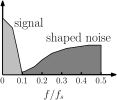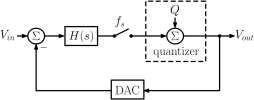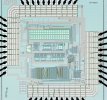
|
General principle of sigma delta modulation
Analog-to-digital conversion automatically implies rounding errors because of the limited accuracy of the quantizer. When the number of quantizer bits is high enough, this approximately leads to a white noise floor in the output spectrum. In sigma delta modulation oversampling is used, this way the signal band is now much smaller than the Nyquistband. The ratio of both is called the oversampling ratio (OSR). The remaining fraction of quantization noise in the signal band is then shaped to higher frequencies (noise-shaping). This enormously reduces the inband noise and thus severely increases the accucracy (see figure for OSR=5).
|
|

Continuous-time sigma delta modulation
To implement the noise shaping, a closed loop system is used. For continuous-time sigma delta modulation this loop consists of an analog filter H(s), a sampler, a quantizer and a D/A-convertor in the feedback loop. The quantizer can be replaced by an extra noise input due to the white noise approximation. By implementing the loop filter as a cascade of integrators, the noise will be strongly suppressed in the output signal band, while the input signal will appear almost unattenuated in this band.
|
|

Third-order prototype with a reduced number of comparators
A third-order prototype was designed for a signal bandwith of 1.5 MHz at an OSR of 32. To achieve a high peak SNR, a 6-bit quantizer was used. Since the number of comparators in this quantizer would be very large, a novel approach is applied which significantly reduces this number.
|
|